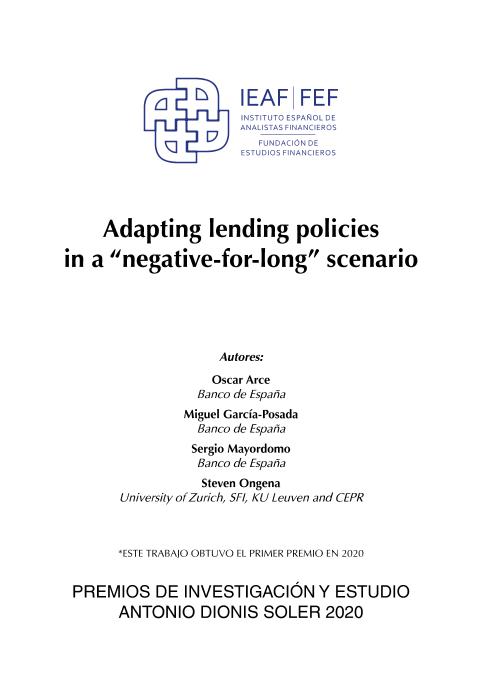Adapting lending policies in a "negative-for-long" scenario

Contenido multimedia no disponible por derechos de autor o por acceso restringido. Contacte con la institución para más información.
| Tag | 1 | 2 | Value |
|---|---|---|---|
| LDR | 00000cam a22000004b 4500 | ||
| 001 | MAP20210011160 | ||
| 003 | MAP | ||
| 005 | 20210409105520.0 | ||
| 008 | 160623s2021 esp|||| ||| ||spa d | ||
| 017 | $aM. 8.646-2021 | ||
| 020 | $a978-84-09-28237-1 | ||
| 040 | $aMAP$bspa$dMAP | ||
| 084 | $a921.91 | ||
| 245 | 1 | 4 | $aAdapting lending policies in a "negative-for-long" scenario$cOscar Arce...[et al.] |
| 260 | $aMadrid$bFundación de Estudios Financieros$c2021 | ||
| 300 | $a51 p. | ||
| 500 | $aEste trabajo obtuvo el Primer Premio en 2020 Premios de Investigación y Estudio Antonio Dionis Soler 2020 | ||
| 520 | $aWhat is the long-term impact of negative interest rates on bank lending? To answer this question we construct a unique summary measure of negative rate exposure by individual banks based on exclusive survey data and banks' balance sheets and couple it with the credit register of Spain and firms' balance sheets to identify this impact on the supply of credit to firms. We find that only after a few years of negative rates do affected banks (relative to non-affected banks) decrease their supply and increase their rates, especially when lowly capitalized and lending to risky firms. This suggests that the adverse effects of the negative interest rates on banks' intermediation capacity only show up after a protracted period of ultra-low rates. | ||
| 650 | 4 | $0MAPA20080546694$aCréditos | |
| 650 | 4 | $0MAPA20080578527$aTipos de interés | |
| 650 | 4 | $0MAPA20080603519$aRentabilidad bancaria | |
| 650 | 4 | $0MAPA20080602772$aOperaciones bancarias | |
| 650 | 4 | $0MAPA20080546991$aEmpresas | |
| 700 | $0MAPA20180005558$aArce, Oscar | ||
| 710 | 2 | $0MAPA20080455651$aFundación de Estudios Financieros |

